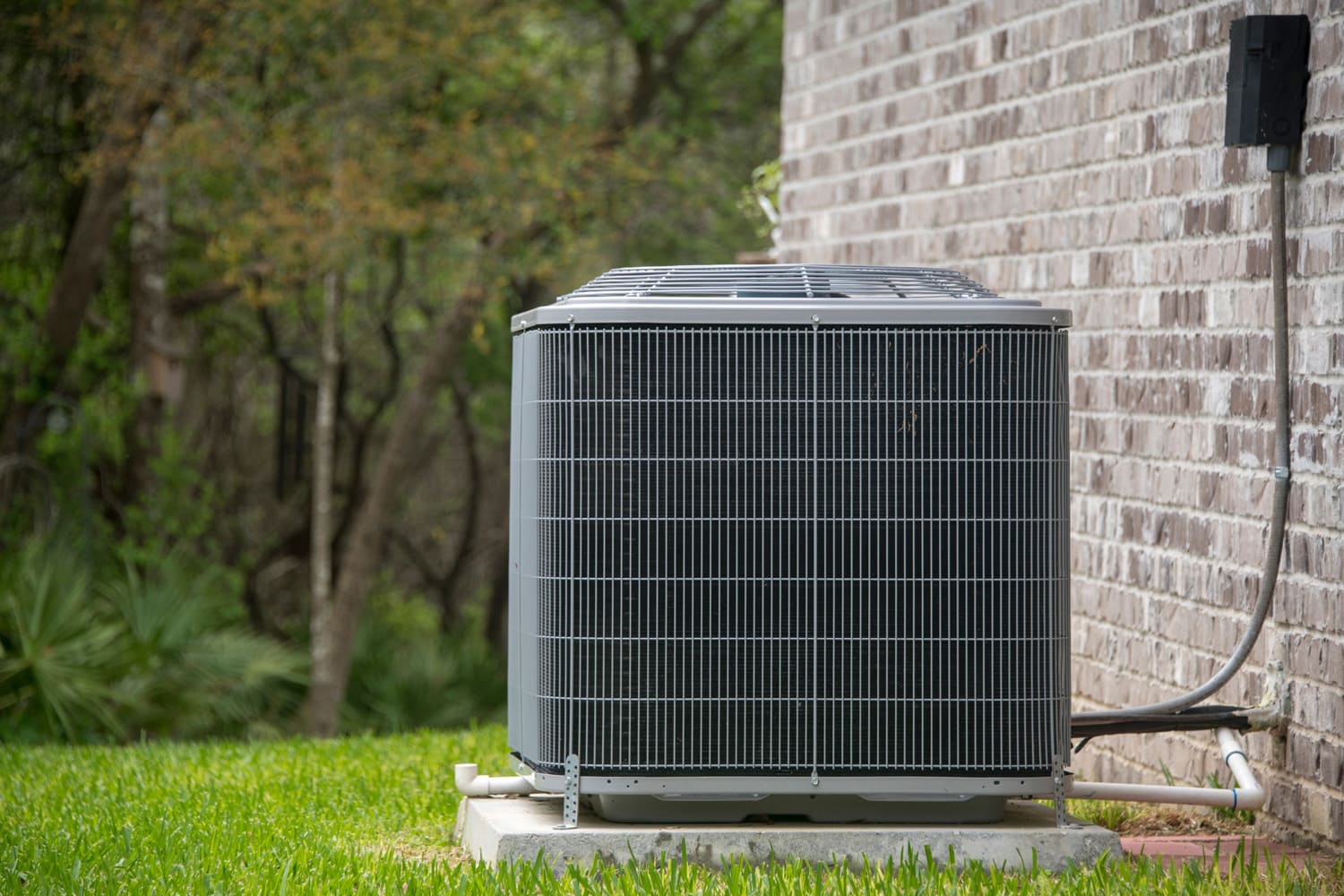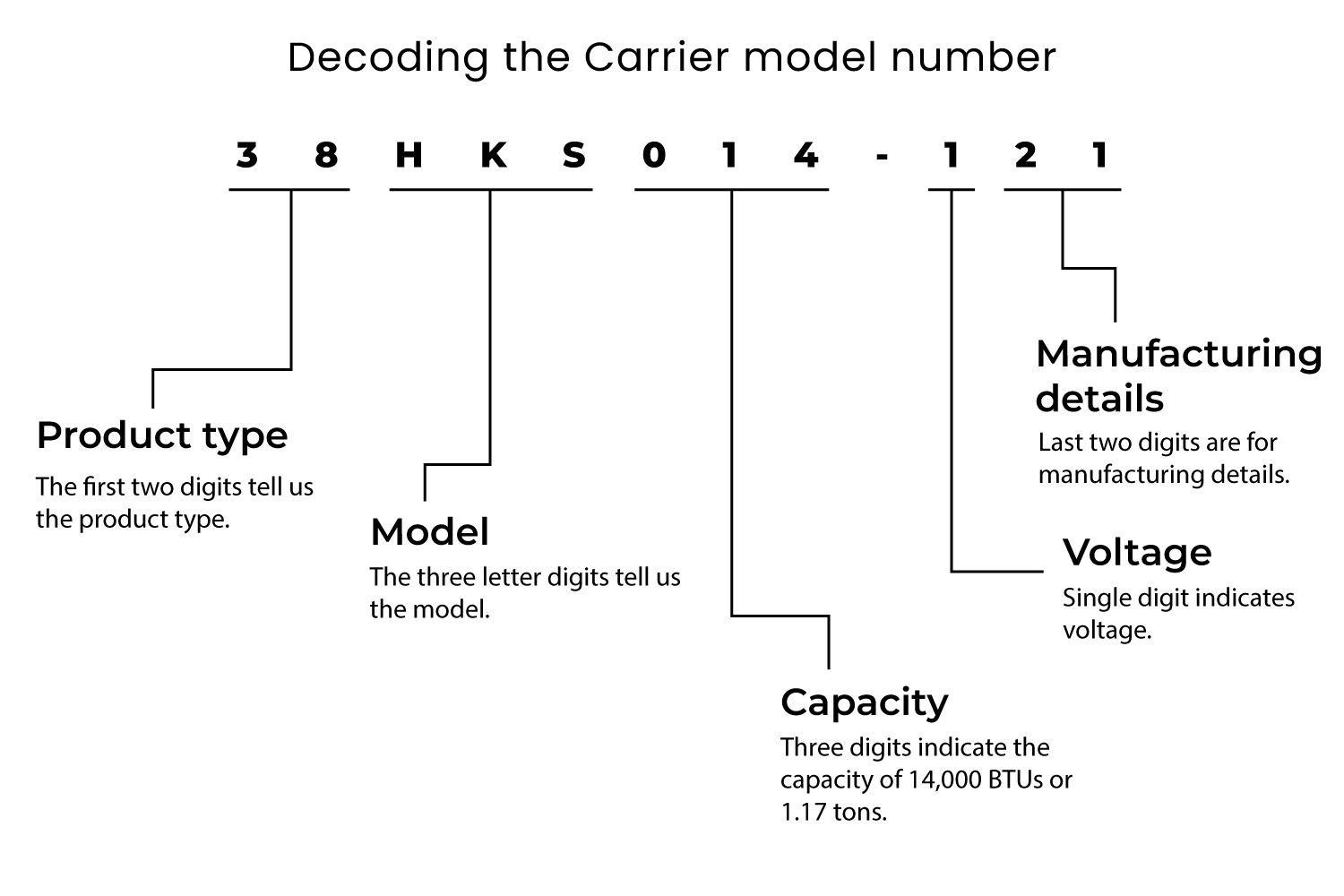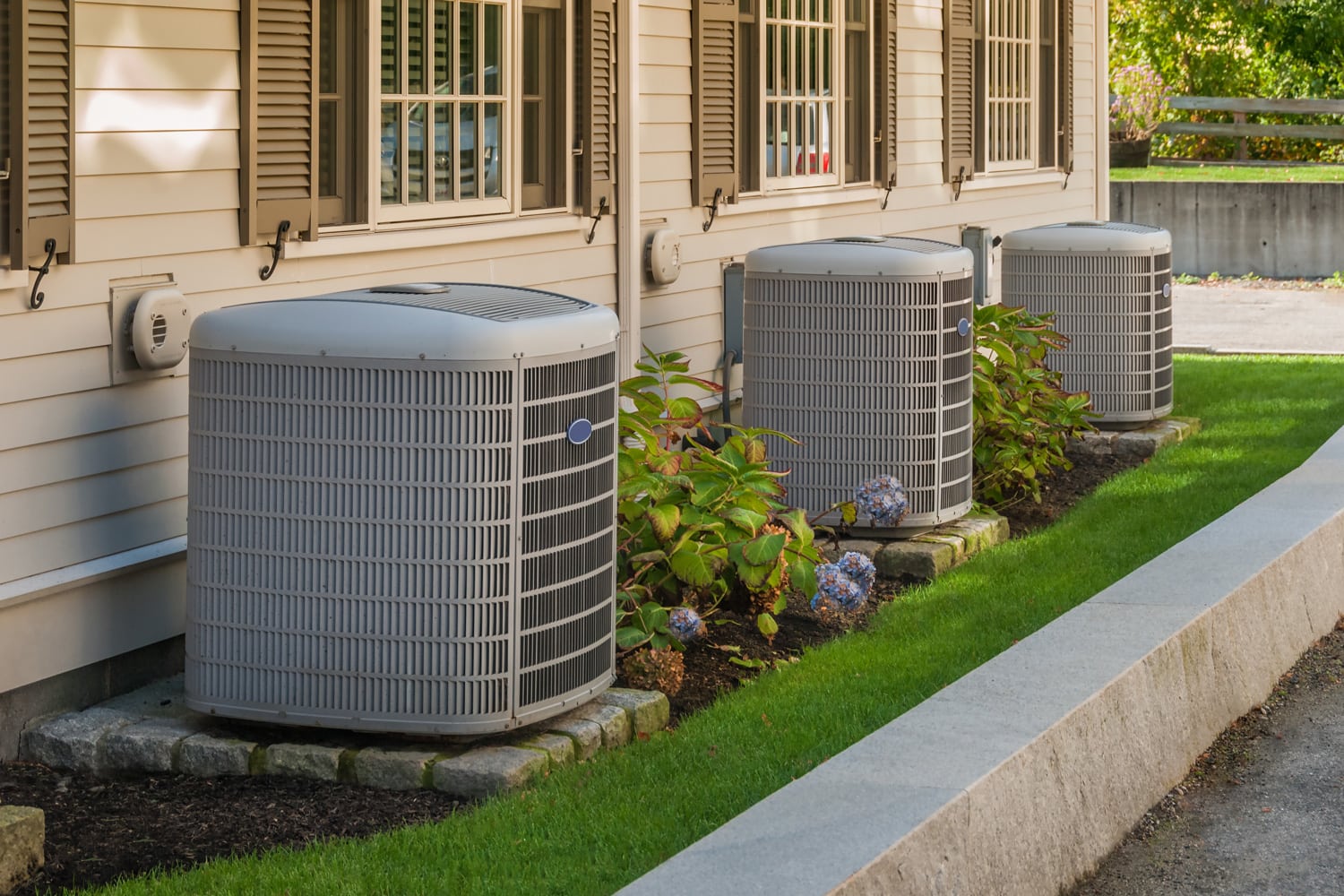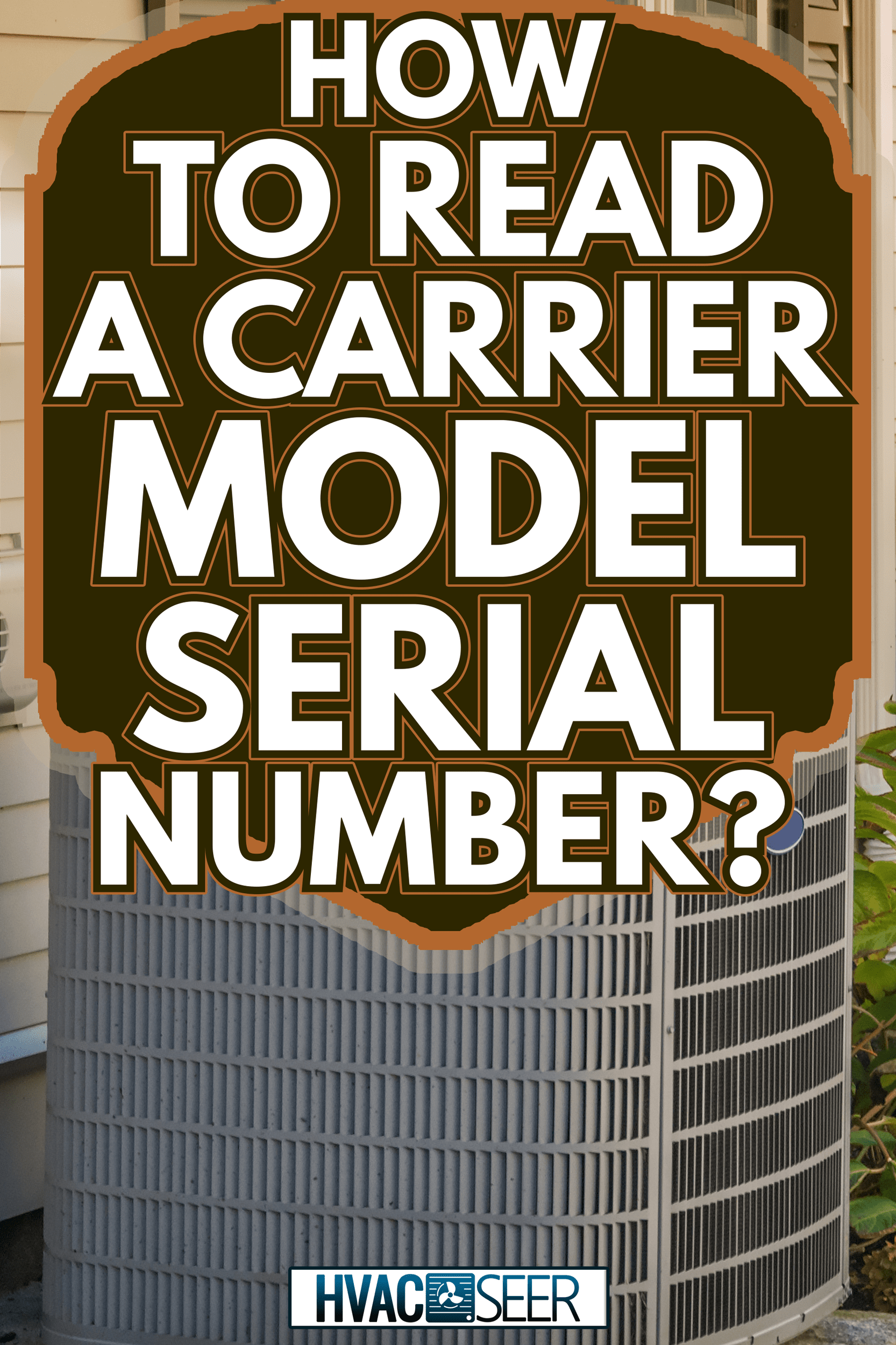Decoding the model and serial numbers of Carrier units can sometimes feel like deciphering a code.
However, these sequences of digits are more than just random numbers as they carry vital information about your unit.
Have you ever wondered how to read these numbers effectively?
Dive into our straightforward guide below and master the art of interpreting both the Carrier model and serial number.
How to Decode Carrier Model Number?

Decoding the Carrier model number can be extremely difficult for those unfamiliar with HVAC terminology.
The Carrier model number provides key information such as the type of product, its model, size (tonnage), voltage, and manufacturing details.
By examining this number, you can determine the size of the air conditioner.
In HVAC terms, the size is often measured in British Thermal Units (BTUs). One ton of air conditioning equals 12,000 BTUs.

Take the example "38HKS014-121":
- The first two digits tell us the product type.
- Next are three letters for the model.
- The following three digits (014 in this case) indicate a capacity of 14,000 BTUs or around 1.17 tons.
- A single digit gives the voltage.
- The last two are for manufacturing details.
You might also like: Carrier Air Conditioner Not Cooling – What’s Wrong?
How to Decode Carrier Serial Number?

Your Carrier serial number, found in either alphanumeric or digit-only formats, reveals the unit's manufacture date and location.
Understanding this number can guide your decision to repair or replace the unit.
Here's a quick guide on how to interpret it.
A.) Alphanumeric
Carrier often uses alphanumeric serial numbers, which blend letters and numbers, to encode specific details about the unit.
Ten Codes
The serial number consists of a pattern: four numbers, a letter, and then five more numbers.
So, if the serial number is 0180A12345, the unit was made in the first week of January 1980 at factory A.
| 01 | 80 | A | 12345 |
| Week | Year | Factory | Unique Seq # |
- The first two numbers show which week the product was made, from 01 (first week of January) to 52 (last week of December).
- The following two numbers represent the year it was made—for instance, 80 stands for 1980, 81 for 1981, and so forth.
- The letter identifies the factory.
- The final five numbers are a unique sequence number.
Nine Codes
The current serial number has nine characters: four numbers, a letter, and four more numbers.
For example, a serial number like 0100V1234 means the unit was made in the first week of January 2000 at factory "V."
| 01 | 00 | V | 1234 |
| Week | Year | Factory | Unique Seq # |
- The first two numbers indicate the week it was made, ranging from 01 for the first week of January to 52 for the last week of December.
- The following two numbers tell you the year, with 00 meaning 2000, 01 meaning 2001, and so on.
- The letter represents the factory where it was made.
- The last four numbers are a unique sequence.
In older nine-character serial numbers, the format is two numbers, a letter, and six more numbers.
A serial number like 16V123456 indicates that the unit was made in the 16th week (April) of 1968.
| 16 (16th of Apr) | V (1968) | 123456 |
| Week | Year | Unique Seq # |
- The two numbers signify the production week, using the same week system.
- The letter corresponds to a specific manufacturing year as detailed below:
- V is 1968,
- W is 1969,
- X is 1970,
- Y is 1971,
- A is 1972,
- B is 1973,
- C is 1974,
- D is 1975,
- and lastly, E is 1976.
- The final six digits are a sequence number.
Eight Codes
This format starts with a letter, followed by a single digit, then five numbers, and ends with another letter.
For example, A598765A signifies that the Carrier A-made was manufactured in January 1975.
| A (January) | 5 (1975) | 98765 | A |
| Month | Year | Unique Seq # | Plant |
The first letter indicates the month (A for January, B for February, and so on). The digit represents the year (5 for 1975, 6 for 1976, etc.).
Five Codes
This type has five characters in the following order: one number, one letter, and three numbers.
The number indicates the year (4 for 1974, 5 for 1975, etc.).
The letter signifies the month (A for January, B for February, etc., using A-M and skipping I; or N-Z skipping O), and the three numbers at the end are a sequence.
For instance, 4A567 means the unit was produced in January 1974.
| 4 (1974) | A (January) | 567 |
| Year | Month | Unique Seq # |
B.) Digits
Some Carrier serial numbers are strictly numeric, using only digits to convey manufacturing information.
Nine Codes (1970 to 1980)
Nine coded Carrier units are manufactured between the years 1970 to 1980.
The first two digits are the year of production, the next two digits are the week, and the rest is the sequence number.
A serial like 760198765 means the unit was manufactured in 1976, the first week of January.
| 76 | 01 | 98765 |
| Year | Week | Unique Seq # |
- Years: "76" stands for 1976, "77" for 1977, etc.
- Weeks: "01" denotes the first week of January, while "52" marks the last week of December.
Seven Codes (>1970)
This type of serial number, used for units made before 1970, has seven digits.
The first digit shows the production year, and the remaining six digits are a unique sequence number.
"1" represents the year 1961, "2" indicates 1962, and so on.
For example, 1987654 means that the Carrier unit was manufactured in 1961.
| 1 (1961) | 987654 |
| Year | Unique Seq # |
Six Codes (1973)
The six-coded serial number was specific to units produced in 1973.
The first digit is the year of production (with "3" representing 1973).
The next digit reveals the calendar quarter, ranging from "01" for the 1st quarter to "04" for the 4th quarter. The final four digits are a unique sequence number.
So, a serial number like 312345 means the unit was made in the first quarter of 1973.
| 3 (1973) | 1 | 2345 |
| Year | Quarter | Unique Seq # |
Where Are The Carrier Model And Serial Number Located?
Begin by consulting your equipment's owner's manuals for the numbers.
However, be careful, as manuals often cover multiple Carrier models, and using the wrong reference can lead to mistakes.
If you've misplaced the manuals, the Carrier model and serial numbers are usually on the unit itself, often at the back or inside the outdoor unit’s metal door.
Look for a rating plate sticker on the top left; it should display both the model and serial number.
Watch this short video for more details.
How Do I Use My Carrier HVAC Model Number?
Your Carrier HVAC model number serves as a gateway to vital system details.
By inputting the model number on Carrier's official website, you can access a wide range of information, from system specifications to troubleshooting tips.
If you face issues with your unit, the model number is instrumental when reaching out to Carrier's customer support.
They can use it to offer precise troubleshooting advice or even schedule a technician visit, ensuring prompt and accurate service.
Always keep your model number handy; it's your primary tool for insights and assistance with your Carrier HVAC system.
How to Determine the Age of a Carrier HVAC System?
Carrier HVAC systems encode their manufacturing date directly within the model's serial number.
The logic behind this encoding is straightforward: the first four digits of the serial number reveal the week and year of manufacture.
- The first two digits represent the week of the year. This can range from 01, signifying the first week of January, to 52, indicating the last week of December.
- The following two digits directly represent the year of manufacture. So, a number like "99" would represent 1999.
So, if you encounter a serial number that begins with "0199", you can decode this to mean the HVAC unit was manufactured in the first week of January 1999.
Continue reading: How Old Is My Carrier Air Conditioner
What's the Difference Between the Old and New Carrier Serial Number?
New units use the first four digits of the serial number to indicate age; the first two digits signify the week, and the next two indicate the year.
Older units, however, have varied formats for their serial numbers, making it challenging to pinpoint their age precisely.
A significant advantage of new Carrier units is that the date of manufacture is now directly visible on the data tag, eliminating the need to decode the serial number.
How Long Does a Carrier Unit Last?
While it varies based on the model, installation, and maintenance, most last between 15 to 25 years.
To gauge your system's age, inspect the manufacturer's label on the unit, which usually lists details like the brand, manufacturing date, model, and serial number.
If unsure about the installation date, use the model and serial number to determine if it's nearing replacement time.
Learn more here: How Long Does A Carrier Air Conditioner Last?
Wrapping Things Up

Carrier's model and serial numbers have evolved in presentation, yet they consistently provide insights into a unit's age, capacity, and production details.
If you can't locate these details on your unit, refer to your user's manual.
By simply knowing how to interpret these numbers, you'll be able to determine your system's age and potential replacement needs.
Did you find this article helpful? Let us know your thoughts!
You can use this image to share this post on your Pinterest board:

